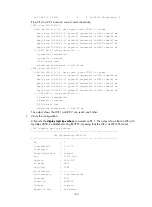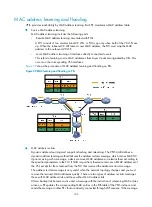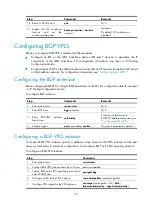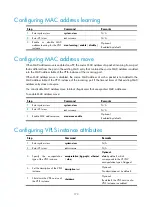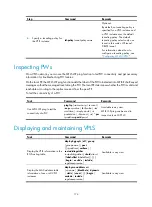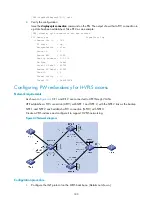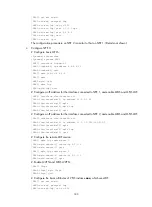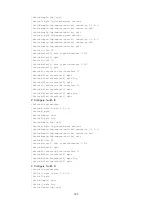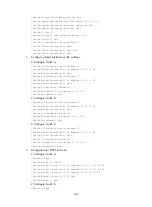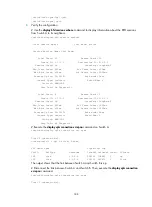
174
Step Command
Remarks
6.
Specify a tunneling policy for
the VPLS instance.
tnl-policy
tunnel-policy-name
Optional.
By default, no tunneling policy is
specified for a VPLS instance and
a VPLS instance uses the default
tunneling policy. The default
tunneling policy selects only one
tunnel in this order: LSP tunnel,
CR-LSP tunnel.
For information about how to
configure a tunneling policy, see
."
Inspecting PWs
On a VPLS network, you can use the MPLS LSP ping function to test PW connectivity and get necessary
information for troubleshooting PW failures.
On the local PE, the MPLS LSP ping function adds the label of the PW to be tested into MPLS Echo Request
messages so that the messages travel along the PW. The local PE determines whether the PW is valid and
reachable according to the replies received from the peer PE.
To test the connectivity of a PW:
Task Command
Remarks
Use MPLS LSP ping to test the
connectivity of a PW.
ping lsp
[
-a
source-ip
|
-c
count
|
-exp
exp-value
|
-h
ttl-value
|
-m
wait-time
|
-r
reply-mode
|
-s
packet-size
|
-t
time-out
|
-v
]
*
pw
ip-address
pw-id
pw-id
Available in any view.
MPLS LSP ping can be used to
inspect only an LDP PW.
Displaying and maintaining VPLS
Task Command
Remarks
Display the VPLS information in the
BGP routing table.
display bgp vpls
{
all
|
group
[
group-name
] |
peer
[ [
ip-address
]
verbose
] |
route-distinguisher
route-distinguisher
[
site-id
site-id
[
label-offset
label-offset
] ] } [
|
{
begin
|
exclude
|
include
}
regular-expression
]
Available in any view
Display the MAC address table
information of one or all VPLS
instances.
display mac-address vsi
[
vsi-name
] [
blackhole
|
dynamic
|
static
] [
count
] [
|
{
begin
|
exclude
|
include
}
regular-expression
]
Available in any view

